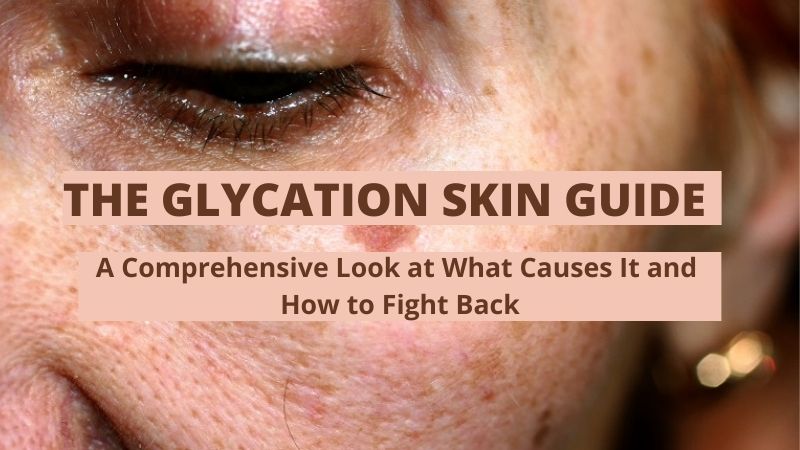
The Glycation Skin Guide
The Glycation Skin Guide: A Comprehensive Look at What Causes It and How to Fight Back
Did you know that your skin ages faster than you do? In fact, your skin is capable of aging 7 times faster than your body. Whether it’s from the sun, a genetic predisposition, or something much more mysterious, the fact of the matter is that as you get older, your skin starts to look older too.
Although your skin is highly resilient and can take a beating, you can help it look and feel younger by taking care of it. Luckily, there are several ways to do just that. In this article, we’ll look at the causes of glycation in skin and the benefits of preventing it.
What Is Glycation?
Glycation is a process where excess sugar in your skin forms advanced glycation end products (AGEs). When glycation occurs a sugar molecule binds to proteins, lipids, or nucleic acids in the skin, causing damage that leads to skin aging. It’s not a foreign event; glycation is a natural part of aging. As you get older, enzymes called glycosyltransferases (GlyTs) start to change. They become less effective at removing sugar from your skin, which causes it to accumulate. You can think of them as sugar-detecting security guards. Their job is to look for sugar and if they find it, they’re supposed to remove it. However, when the guards are less effective, they don’t remove enough sugar from your skin, which causes it to age faster.
These molecules, if left unaddressed, can cause irreversible damage and inflammation in your skin. This can lead to a few different skin-related problems, including hyper pigmentation, loss of plumpness, and wrinkles.
What Causes Glycation?
Glycation is caused by two primary factors. The first is the build-up of AGEs over time. These AGEs build up when excess sugar is continually added to your skin, which essentially damages the collagen and elastin in your skin. The second is exposure to harmful UV rays and free radicals. In both cases, excess sugar is added through the process of glycation.
However there are other reasons why glycation happens, here is comprehensive list. These include:
- Harmful UV rays
- Free radical damage
- Exposure to smoke and other tobacco products
- Excessive alcohol intake
- Foods that contain high levels of sugar, such as candies, pastries, and donuts
- High levels of obesity
- Genetic predisposition (especially in darker-skinned people)
- Problems Caused by Glycation in Skin
As we mentioned earlier, glycation is a natural part of aging. However, it can cause problems where it shouldn’t. In some cases, it can lead to skin cancer. In others, it can cause skin aging. Other side effects include: Uneven skin tone and texture skin roughness, wrinkles, and loss of elasticity, dryness and irritation of the skin.
You may notice that you appear older than your age – Glycation appears to accelerate the aging process on skin. Since glycation is a metabolic process, it can happen in both the skin and hair. This means, as you get older, you may notice your skin wrinkles and fine lines appear more prominent than they did before. It can also break down the protective barrier function of your skin, leaving it dry, dull, and even more prone to damage. In addition, glycation can also accelerate hair loss.
Damage to skin
When glycation occurs, it can damage skin cells. This can lead to skin redness, and flaking lack of moisture, loss of collagen, and uneven texture. It can also make skin more susceptible to visible aging, such as wrinkles and fine lines.
Damage to hair
Your skin also makes proteins that help your hair stay healthy. When glycation occurs in your skin, these proteins are altered, making it more likely for your hair to fall out due to breakage. In addition, glycation can also alter hair protein, making it weaker. This can lead to hair breakage, frizziness, and even increased chance of developing split ends.
Loss of skin barrier function
The skin is the largest organ of the body, but it is also one of the most delicate. A healthy skin barrier is key to protecting your internal organs, as well as your skin cells, from harmful chemicals, bacteria, and other potential pathogens. The skin barrier is made up of several different layers. The topmost layer is the skin surface, which is the visible portion of your skin. The second layer is the dermal layer, which is the deeper skin layer located just under the epidermis.
The dermal layer is important because it helps to regulate the amount of water and oxygen that can pass through your skin. If it’s compromised by glycation, this can lead to dehydration and sensitivity.
How to Prevent Glycation in Skin
The first step to preventing glycation in skin is to avoid the triggers. UV rays, smoke, alcohol, and a diet high in sugar are the main ones, but there are others.
Luckily, there are many ways to do just that. For example, drinking water regularly can prevent excessive build-up of AGEs in the skin. It’s also important to take care of your skin by keeping it moisturized and well-rested. This includes using sun protection to prevent UV damage. The next step is to use products that prevent glycation.
My favorite product to support the removal of glycation from the skin is Anti Glycation Extreme Pill. (also called the A.G.E. Pill).
The product speaks for itself check out these amazing before and after photos of people using our Anti Glycation Extreme Pill (A.G.E. Pill).
Conclusion
Glycation is an unavoidable part of aging. Although your skin is highly resilient and can take a beating, you can help it look and feel younger by taking care of it. Luckily, there are several ways to do just that.
You can take steps to prevent it from occurring in your skin. Avoid the triggers, use products that prevent glycation, and you can keep your skin looking and feeling younger.
Lear more about our Anti Glycation Extreme Pill which goes to work and supports the removal of glycation at the deeper layers of the skin.
Last Updated on March 27, 2023 by Katie Sisel Distributor
